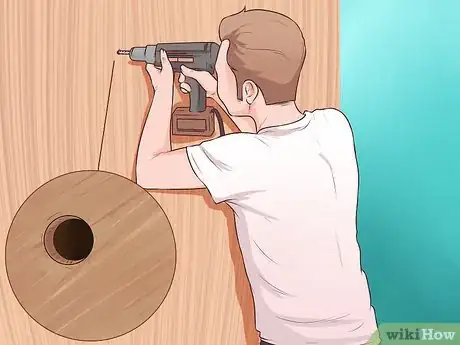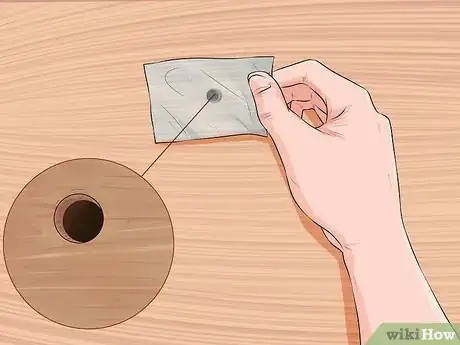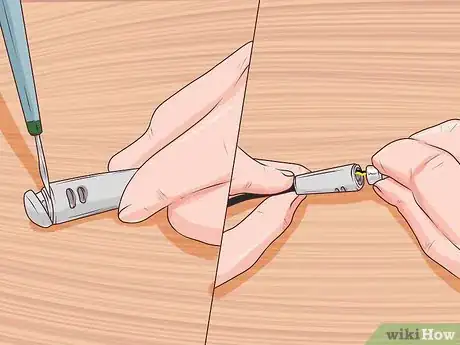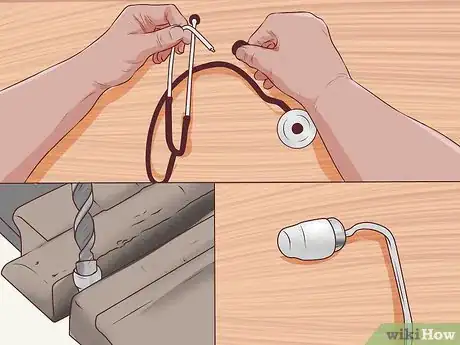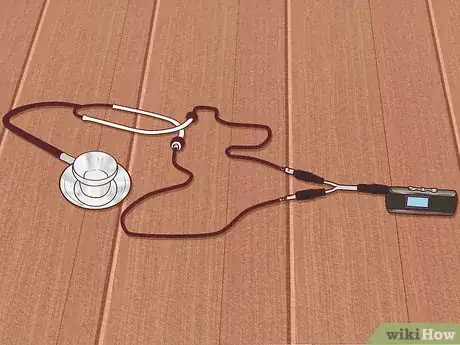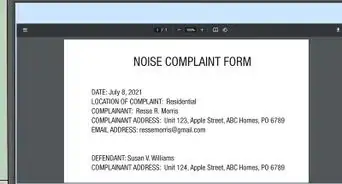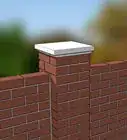wikiHow is a “wiki,” similar to Wikipedia, which means that many of our articles are co-written by multiple authors. To create this article, 25 people, some anonymous, worked to edit and improve it over time.
There are 13 references cited in this article, which can be found at the bottom of the page.
This article has been viewed 1,012,104 times.
Learn more...
Wondering about that muffled conversation on the other side of your wall? Do you wonder what’s being said? Whether it’s on a stranger or loved one, or in your own home or elsewhere, it’s probably not a good idea to spy. However, if you decide to go ahead and eavesdrop, there are several ways to listen through walls with a surprising amount of clarity. Just be sure that you know the law and criminal risks if you decide to act.
Things You Should Know
- Place an empty glass or spy stethoscope (store bought or homemade) against a clear spot on the wall that’s unobstructed by studs or other structures.
- Alternatively, drill a very narrow hole through the wall and cover it with plastic wrap to draw sound through the hole.
- Remember that eavesdropping or spying may have ethical or legal consequences. Weigh the potential risks before you start listening.
Steps
Using a Glass
-
1Get a glass. So you’ve decided to go for it. How do you get started spying? One method is a simple glass held against the wall. The reason this works is that you create an “acoustic coupling” between the wall and the glass, allowing sound waves to travel from one side to the other.[1] A soda or beer glass works best. Some eavesdroppers also swear by Dixie cups, but glass seems to conduct sounds better than other kinds.
- Experiment with different types and shapes of glasses to see which one works best for your purposes.
- If you have an iPhone, you can download the Amplitude Pro app and hold the iPhone to the glass against the wall. This app allows you to hear distant sounds much more clearly, but it also records and saves the amplified noise.
-
2Scout for the clearest spots. Some places on a wall will transmit sound more clearly than others for reasons of structure or distance from the source of the sound. Experiment to test the sound quality, until you find the best place. Sometimes this can be difficult if the sound is coming from the ceiling. If you're too far away from the sound on the wall, you won't hear things very clearly.Advertisement
-
3Place the rim of the glass against the wall. Remember, in order for it to work you have to couple the wall and glass acoustically. Do this by placing the glass flat, rim down, against the wall. Now sound waves will go from the wall into the glass and make it easier for you to detect them.
- Once the glass is in place, put your ear to the bottom of the glass. Continue to move the glass on the wall if you can’t hear well.
Using a Hole
-
1Drill a tiny hole. Another way to hear through a wall is with a hole and plastic membrane, a method recently discovered by scientists in Japan and South Korea. First, drill a very small hole all the way through the wall. A power drill with a small, long bit will work best to do this. [2]
- Don’t expect to hear too much through the hole alone. In fact, a plain hole in a wall seriously hinders sound transmission.
- Try to pick a time when your neighbor is out to drill through the wall. Otherwise, they may well notice the sound or debris from the drilling.
-
2Cover the hole with a thin membrane. This is what should make the method work really well. Studies show that when you cover the hole with a thin membrane on one side the transmission becomes almost as if there is no wall, because the membrane equalizes the pressure on both sides of the hole and funnels sound through.
- Try using a common household item, namely plastic wrap. In fact, the scientists who conducted the initial study used plastic wrap themselves.[3]
-
3Listen away. Once you have your hole and plastic wrap in place, listen away! If executed properly, you should be able to hear what is happening in the opposite room quite clearly.
- For even better results, try this method in conjunction with the first. Put a glass over the top of the hole and plastic membrane.
- Be aware that drilling a hole in the wall has very clear disadvantages, especially as regards secrecy. Your neighbor might hear the drilling; she might see the hole; or she might notice the drill debris on the floor and become suspicious. Use with care!
Using a Spy Stethoscope
-
1Collect your materials. We’re now getting into more sophisticated listening equipment. You can either make a listening stethoscope on your own or buy one. Premade models will save you time but can cost several hundred dollars. Unlike a premade model, however, making your own stethoscope will probably cost around or under $25, provided that you already have a fairly good MP3 player.
- You can typically find a stethoscope at your local drugstore for about $10. The quality of the stethoscope is unlikely to make much of a difference.[4]
- You will also need microphones. Stereo multimedia microphones are preferable, as they are cheap (around $15) but have fairly good sound specifications. That is, you should be able to pick up sound with them pretty easily and with fair quality.[5]
- Finally, you will need to have an MP3 player to record sound as well as a 3.5mm (mini) Stereo Y-adapter cable. The cable will be quite cheap, about $3 or $4 dollars. The MP3 player will be the most expensive item if you do not already own one. Keep in mind that it must be able to record, which probably means that you will need a newer model (many older ones do not record but only play music).[6]
-
2Disassemble the microphones. You will need to cut down the middle of the microphones in order to get to the wiring, remove the tops or headers, and release the microphones. You will then insert the exposed microphones into the stethoscope earpieces.[7]
- A good tool for doing this is an X-Acto knife. It will make a clean cut through the outer parts of the microphone and let you get to the innards. You should be left with 2 mics and 3.5 mm connectors (the cabling).
-
3Disassemble and reassemble the stethoscope earpieces. Remove the earpieces from the stethoscope. This is fairly easy and they should just pop right off. Don't get rid of them, however, as you'll need to attach them to the microphones.
- Next, gently drill shallow holes into each of the plastic earpieces to a diameter that matches that of the microphone housings. The size of these holes needs to be exact, as the microphones must fit squarely inside of them. A power drill or grinder can give you the desired precision.[8]
- Glue the microphones inside the earpieces. Put a dab of glue around the edges of the microphone housings and then insert them into the holes that you have just drilled in the stethoscope earpieces. Reattach the earpieces back to the stethoscope and let the glue dry.
-
4Hook the stethoscope to MP3 player. Last, attach the stethoscope and microphones to the MP3 player. Use the Y-adapter cable to connect the microphones to the MP3 player. The sound that you pick up through the wall will now be collected and amplified by the microphones, transmitted to the MP3 player, and recorded or saved.[9]
- Plug the single stereo connecter in to an MP3 player. Your spy stethoscope should be ready to go now.
-
5Start listening. Practice first with your stethoscope. As with an ordinary glass, you may have to experiment a bit to find a good placement on the wall or to get the hang of recording. However, unless the walls are double-glazed or have thick insulation, you should be able to hear what is being said on the opposite side.
Knowing the Consequences of Spying
-
1Ask yourself: do you really want or need to spy? By listening through a wall, you are about to spy on another person and violate private conversations. This raises big legal and ethical problems. Before acting, seriously ask yourself if you want to do it. Is it worth the risk?
- The situation is important. In England, for instance, a man rescued his elderly neighbor from a robbery by listening through the wall with a glass.[10] In his situation, spying was definitely justified.
- Things are rarely so clear cut, however. You should probably not act if you have any doubts about the situation. If you decide to go ahead, make sure that you know the possible consequences of your actions.
-
2Be aware of eavesdropping laws. Eavesdropping means to overhear, record, magnify, or transmit any part of a private conversation without the consent of at least one person involved. Be aware that states have laws against eavesdropping. By spying you may well be breaking the law; you might even be violating the law by possessing a device for spying.[11]
- Your state may have a “one party consent” or “two party consent” law. One party consent means that it is illegal to eavesdrop unless you have the consent of at least one of the people engaged in a private conversation. In two party consent you must have permission from both parties to listen, record, or amplify their communication.[12]
- Take the state of Michigan. Michigan has a two party consent law – you must have permission from all parties in order to “overhear, record, amplify, or transmit any part of a private discourse.” This applies even in your own home. Eavesdropping there is also a felony.[13]
-
3Consider all negative consequences. What happens if you eavesdrop and someone finds out? What could happen to you? This is a good question and you should consider all of the possible outcomes, which in many cases are severe.
- In Michigan, the penalties for illegal eavesdropping are up to 2 years in prison, up to $2,000 in fines, or both.[14] In California, eavesdropping is either a misdemeanor or felony. As a misdemeanor you face up to 364 days in jail and a $2,500 fine; as a felony, you could spend up to three years in prison and a $2,500 fine.[15]
- Of course, a criminal penalty is not the only bad outcome. You also open yourself to a civil lawsuit for violating someone’s privacy, which could be costly and run into the thousands of dollars. Even if you escape legal consequences, you could have a very angry person on your hands.
Community Q&A
-
QuestionHow do sound waves travel through walls?
 wikiHow Staff EditorThis answer was written by one of our trained team of researchers who validated it for accuracy and comprehensiveness.
wikiHow Staff EditorThis answer was written by one of our trained team of researchers who validated it for accuracy and comprehensiveness.
Staff Answer wikiHow Staff EditorStaff AnswerUnlike light, which is reflected from an opaque wall and cannot travel through, some of the sound waves are not reflected but continue to move through the wall, causing the wall to vibrate and transmit the sound. However, what is inside the cavity of the wall can affect how much sound travels through to the other side of the wall; if the wall is fairly solid, there is little to disperse the sound waves and some of the sound will make it through. If the cavity contains cords, insulation batting, etc., the sound waves are more likely to be scattered, which can mean that little or no sound gets through to the other side. Hence, a soundproofed wall won’t let the sound waves pass through.
wikiHow Staff EditorStaff AnswerUnlike light, which is reflected from an opaque wall and cannot travel through, some of the sound waves are not reflected but continue to move through the wall, causing the wall to vibrate and transmit the sound. However, what is inside the cavity of the wall can affect how much sound travels through to the other side of the wall; if the wall is fairly solid, there is little to disperse the sound waves and some of the sound will make it through. If the cavity contains cords, insulation batting, etc., the sound waves are more likely to be scattered, which can mean that little or no sound gets through to the other side. Hence, a soundproofed wall won’t let the sound waves pass through. -
QuestionIs it against the law to eavesdrop?
 wikiHow Staff EditorThis answer was written by one of our trained team of researchers who validated it for accuracy and comprehensiveness.
wikiHow Staff EditorThis answer was written by one of our trained team of researchers who validated it for accuracy and comprehensiveness.
Staff Answer wikiHow Staff EditorStaff AnswerThere is a "crime of eavesdropping" in many jurisdictions which involves intentionally overhearing, recording, amplifying or transmitting a private conversation in a private place without permission of the persons being listened to. Overhearing conversations in public is not usually covered by this, as people can expect to be overheard when in public. Using a listening device, wire-tapping, recording private conversations, etc., are generally activities considered to be illegal where consent is absent, although exceptions exist for law enforcement, employment and safety reasons. Since the laws vary by jurisdiction, it’s important to know your local legislation to get an accurate answer to this question in your location.
wikiHow Staff EditorStaff AnswerThere is a "crime of eavesdropping" in many jurisdictions which involves intentionally overhearing, recording, amplifying or transmitting a private conversation in a private place without permission of the persons being listened to. Overhearing conversations in public is not usually covered by this, as people can expect to be overheard when in public. Using a listening device, wire-tapping, recording private conversations, etc., are generally activities considered to be illegal where consent is absent, although exceptions exist for law enforcement, employment and safety reasons. Since the laws vary by jurisdiction, it’s important to know your local legislation to get an accurate answer to this question in your location. -
QuestionCan stethoscopes hear through walls?
 wikiHow Staff EditorThis answer was written by one of our trained team of researchers who validated it for accuracy and comprehensiveness.
wikiHow Staff EditorThis answer was written by one of our trained team of researchers who validated it for accuracy and comprehensiveness.
Staff Answer wikiHow Staff EditorStaff AnswerMedical stethoscopes are sensitive and may be able to hear through a wall, while the less sensitive mechanical stethoscopes might work for a thin wall but there’s no guarantee. If using an unmodified stethoscope, you’ll need to experiment a bit, such as having a friend talk in the other room and seeing if you can hear what they’re saying while moving the scope around until the sound is clearest. However, as explained in the above article, for a stethoscope to be most effective at hearing through walls, it requires modification by adding microphones to amplify sounds muffled by the wall. There are spy stethoscopes, which are expensive, but are modified already to hear through walls; do your research if getting one. Finally, the materials and thickness of the wall will make a difference to whether or not you can hear through it with a stethoscope, modified or not.
wikiHow Staff EditorStaff AnswerMedical stethoscopes are sensitive and may be able to hear through a wall, while the less sensitive mechanical stethoscopes might work for a thin wall but there’s no guarantee. If using an unmodified stethoscope, you’ll need to experiment a bit, such as having a friend talk in the other room and seeing if you can hear what they’re saying while moving the scope around until the sound is clearest. However, as explained in the above article, for a stethoscope to be most effective at hearing through walls, it requires modification by adding microphones to amplify sounds muffled by the wall. There are spy stethoscopes, which are expensive, but are modified already to hear through walls; do your research if getting one. Finally, the materials and thickness of the wall will make a difference to whether or not you can hear through it with a stethoscope, modified or not.
Things You'll Need
For the Glass Method:
- a glass
- a wall
- an iPhone with the Amplitude Pro app (optional)
For the Spy Stethoscope:
- A stethoscope
- Stereo multimedia microphones
- 3.5 mm (mini) Stereo Y-adapter cable
- X-Acto knife (or similar)
- Small drill
- Glue
References
- ↑ https://books.google.ca/books?id=4sM_JsS4A3kC&pg=PA2&lpg=PA2&dq=sound+waves+glass+against+a+wall&source=bl&ots=_CN2NJa6E0&sig=SJLPGQl6QbJJMImB5tKU8MEH2aM&hl=en&sa=X&ved=0CDsQ6AEwB2oVChMI28TRr7b3yAIViyceCh37qA6v#v=onepage&q=sound%20waves%20glass%20against%20a%20wall&f=false
- ↑ https://www.insidescience.org/content/pinholes-and-plastic-wrap-send-sound-through-walls/1034
- ↑ http://physicsbuzz.physicscentral.com/2013/06/hearing-through-walls-with-household.html
- ↑ http://gizmodo.com/304765/eavesdrop-through-walls-with-a-do-it-yourself-recording-spy-stethoscope
- ↑ http://www.instructables.com/id/High-Tech-Spy-Stethoscope!/
- ↑ http://www.instructables.com/id/High-Tech-Spy-Stethoscope!/
- ↑ http://www.instructables.com/id/High-Tech-Spy-Stethoscope!/step2/Disassembly/
- ↑ http://www.instructables.com/id/High-Tech-Spy-Stethoscope!/?ALLSTEPS#step4
- ↑ http://www.instructables.com/id/High-Tech-Spy-Stethoscope!/?ALLSTEPS#step5
- ↑ http://www.telegraph.co.uk/news/uknews/crime/11287575/Grandfather-used-glass-to-listen-through-wall-and-hear-burglar-attacking-94-year-old-neighbour.html
- ↑ https://www.rcfp.org/reporters-recording-guide/introduction
- ↑ http://definitions.uslegal.com/e/eavesdropping/
- ↑ http://www.audioforensicexpert.com/eavesdropping-is-it-worth-the-risk/
- ↑ http://www.audioforensicexpert.com/eavesdropping-is-it-worth-the-risk/
- ↑ https://www.wklaw.com/can-convicted-eavesdropping-public-conversation/
About This Article
To hear through walls, start by finding a drinking glass with a wide rim. Then, hold the rim of the glass against the wall you want to listen through and rest your ear on the bottom of it. Sound waves will travel through the wall and into the glass, making it easier for you to hear through it! If you still can't hear anything, try moving the glass around on the wall until you find a spot where the noise is transmitted clearly. To learn how to use a spy stethoscope to hear through walls, scroll down!



